In 2006, Gill released the most ambitious– and expansive–album of his career. These Days is a 43-song, four-disc opus that allowed him to explore everything from hardcore country to gospel and blues. When it came time to write music for his latest effort, Guitar Slinger, Gill knew that, in the end, he was at the mercy of the songs. “I was thrilled that the first song that I wrote after that project was ‘The Old Lucky Diamond Motel.’ It’s a real neat story song, kind of Americana,” remembers Gill. “I finished it and then looked back at the last record and said, ‘Wow, that’s a relief. It’s nothing like anything on the last record.’ It gave me a really good jumping off point and I think, more than anything, that I am so much more interested in the songs these days and what they are and what they’re about than anything else.”
Even though the album title brings to mind finger-busting licks, Gill demonstrates the restraint and well-developed sense of taste that he’s known for. “The songs lead me to play more guitar, or be more country, or rock harder,” states Gill. We catch up with Gill to discuss vintage guitars, balancing the roles of a songwriter and guitarist, working with your heroes, and if he would ever work with a band again.
Did the title for the album come about
while you were writing the material, or
did you already have it in mind?
The idea for the album title came from my
manager, Larry Fitzgerald, who I’ve been
working with for 28 years. As he listened
to the record he said, “There is something
different about your playing. It just sounds
completely free on this record. Generally,
you would drift towards a solo in the middle
and that would be about it. These songs have
like two-minute jams on the end. You are
really blowing it up, so I think you should
call this record Guitar Slinger.” At first, that
song wasn’t going to be on the record. I
said, “Well, if we don’t put that song on the
record, that doesn’t make a lot of sense.” I
like that it had a sense of humor in it. It’s
poking fun of Amy [Grant], and poking fun
at me losing all that stuff in the flood last
year. I like the sense of humor in that song.
poking fun of Amy [Grant], and poking fun
at me losing all that stuff in the flood last
year. I like the sense of humor in that song.
You really let loose on some of these tracks.
I guess it’s more guitar than usual for about
half of the record. The other half is mainly
country and story songs. Still, I had a blast
playing a little more than usual.
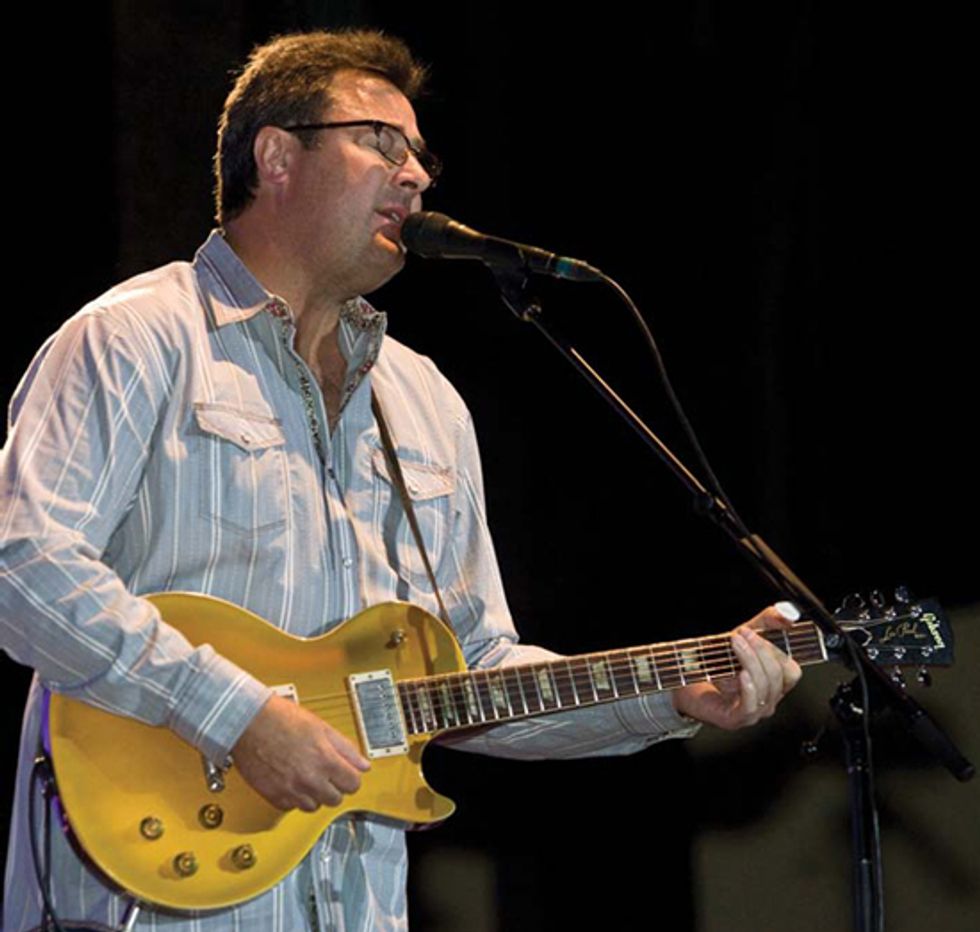
“Threaten Me With Heaven” has one of
the most powerful solos on the album.
I felt like the power of that song needed
that kind of angst in it. Not a choir-like
thing, but with those background singers
it sounds like arena rock to me. I’m always
trying to play what’s appropriate for the
song and the arrangement, so that’s the
reason, to me, that it has that non-stop kind
of blitzing mentality at the end. I made this
record with Justin Niebank, who is a great
musician, and he said, “There is this one
time where you hit this two-note thing and
the bottom note almost harmonically does
something. It is so emotional.” To me, that’s
what playing is all about. It could be a subtle
solo on something like “Who Wouldn’t
Fall in Love With You”—the greatness in
playing is in the subtle things that really
have emotion. You can play every lick in the
world, but if there is nothing in it that has
emotion, it’s not going to move anybody.
What guitar did you use on that?
Oh gosh, I want to say it was a Les Paul.
Mike McGuire over at Gibson has made me
a few reissues of those classic Bursts. I can’t
pull the trigger on buying a real one, as
much as I want one. There’s just no better
sound in the world than those PAF pickups
from ’59-’60. I probably played a ’59 tweed
Fender Bassman. It’s a pretty good go-to
amp. I never write any of this stuff down, I
just go in and try stuff out. I did get to play
Duane Allman’s ’57 goldtop a few months
ago and it was one of the highlights of my
life. The sound of it was unlike any Les Paul I had ever heard and a lot of it has to
do with those pickups. The history of that
guitar and everything was pretty magical.
I know you lost quite a bit of gear in the
flood. Were there any guitars that you
thought were lost that came back to life?
There were a few things. I had a ’54 Strat
that I thought was a goner. It came back
to life with a little bit of finish damage. I
have a Gibson Johnny Smith that I think
is gonna live [laughs]. He is still in pieces,
but I have a feeling that it will turn back
up. I messed it up once before by forgetting
it was in the car and the neck bowed like a
bow and arrow. My friend Joe Glaser saved
it before, so I think it will be fine. I lost a
ton of stuff but the hard part was losing
some stuff that had been on certain solos
or intros over the years. I got killed on the
cases. I lost 60 of them and a lot of them
were vintage cases for Martin guitars from
the ’20s and ’30s. The insurance adjuster
was shocked that a case could be worth four
or five thousand dollars. It was painful. I
lost a lot of stuff that was very unnecessary.
It could have been a lot worse. It could
have been a lot better. It was what it was. I
have been having a pretty good time replenishing
and finding cool stuff. That is the
one thing that I am just completely nuts
about is finding great guitars.
When you are out on the road do you
search out cool gear?
Sure. I occasionally search them out. A lot
of times guitars will find me. People know I
like old ones and I have had a few show up
that were great, old guitars that might have
belonged to their mom or dad or grandfather.
One thing that I am proud of is that
I am a collector, not so much a buyer and
seller. I have never gotten rid of any guitars,
so I’m not the type of collector that takes
them and puts them under the bed and
never plays them again. I buy these guitars
and take them on the road, find a way to
put them on records or take them out to
the Opry and play them. I think guitars are
meant to be played, even though some of
them are six-figure instruments. I just strap
them on and go play them.
I once heard that you should be weary of
vintage instruments that are in pristine
condition because that meant they weren’t
good enough for someone to really play.
It’s true. I mean just the value of collectable
instruments is more based on its condition
rather than how good it sounds. I never got
an instrument that didn’t feel good in my
hands. A couple years ago I played a ’59
ES-335 and the neck profile was just a hair
big for me. I know ’59 is the most soughtafter
year, but my hands are not big enough
to where that neck profile feels comfortable
for me. This guitar was unbelievable. I knew
how good it would sound because of the way
it sounded acoustically. I can tell a lot about
an electric guitar because of that. I told the
guy as much as I want this and knowing how
savage it would sound, I don’t think I would
play it just because it didn’t fit in my hands quite right. All the stuff I have picked up is
pretty great. I am not interested in collecting
a mass of stuff that doesn’t speak to me.
It sounds like you are really focused on
the connection between a specific guitar
and amp to get your tone. Do you use
many effects?
Occasionally. In the studio I want to get
the amp to do the right thing just plugged
straight in. After the fact, you can add delay
or whatever you want on it. I use some pedals,
not a lot. It’s usually something to give
it a little more gas. I really like this pedal
made by Hermida Audio called a Zendrive,
which I think is really great. I have another
pedal that is really just a boost [Creation
Audio Labs MK.4.23]. It kicks it just a hair
and doesn’t alter the tone drastically and
adds just a little sparkle. In the studio, it’s
really all about getting the amp and the guitar
to do just the right thing.
Where did you record this album?
At my house. I put a studio in my house and it
has been the most life-changing thing I think I
have ever done. The atmosphere here is relaxed
and it’s a peaceful feeling here in this house.
There are windows all around the studio and
you look out and see blue skies and trees. It’s
gorgeous here. The guys really enjoy the vibe
here and it really made for a creative stretch.
How do you balance being a songwriter,
a singer, a guitarist, and in some cases,
a producer?
I think you have to be wise enough to edit
yourself and play what fits.
Do you find that difficult?
No, I think it’s a fun challenge. If you work
on something and say to yourself, “I just
played 11 notes in this four-bar phrase.
Would eight be better?” You just massage
it and milk it and find a way to make it
speak the most. That’s the thing that happens
to you later in your musical life. You
learn more what not to play and that the
real greatness is in the nuances of subtleties.
I think in the writing process I know
certain songs are written to be a vehicle
to play the guitar. Others will have a great
groove that will lend to some playing. Some
songs won’t. A lot of songs don’t need a big
ripping solo, or really much of anything.
It’s all about serving the song and deciding
what is the right thing to do.
You really show off your blues side on
“When the Lady Sings the Blues.” How
did that song come together?
When I was young, Diana Ross made that
movie, When the Lady Sings the Blues, about
Billie Holiday. I gotta tell ya, I probably
saw that movie 100 times. We had a little
theater about a block from my house and
I would go over there and pay and see the
movie and then hide behind the curtain or
run to the restroom and hang out to see it
again. I was just completely overwhelmed
by that music and had never heard of Billie
Holiday until that movie. I didn’t know
who this woman was, but the music was
unbelievable, so I just had to find out what
it was all about. It sent me on a pretty
neat path towards that slant of music.
As we were writing that song I thought,
“Wait a minute, we could massage this a
little bit and it could be a really neat hard
times song.” When you are struggling with
hard times, nothing is better than listening
to Billie Holiday. A singer like that is
the epitome of that style. She had some
kind of thing in her voice that was melancholy,
blue, and just completely mesmerizing.
I thought it was a neat idea to do a
more modern blues, Steely Dan-ish song.
Lyrically, it makes you think of the depression,
with the soup lines and people struggling.
That is one tune that warranted a lot of playing at the end. It was so much fun to
just cut loose and play the blues. Hopefully
it didn’t get stale. I just loved where it went
and how the track massaged itself around it
and halfway through it lifted and went to
the next place. It’s a really neat record of a
bunch of guys listening to each other and
making it go somewhere.
Sounds like you used a Strat on that solo?
Yeah, that was a ’59 Strat. Recently, I bought
another Strat that used to belong to Duane
Eddy. He bought it brand new when he lived
out in Fullerton [California]. He never really
played it and then gave it to his son. His son
tracked me down in the process of wanting
to sell it and I thought it had a pretty good
history. Duane is a pretty good friend of mine
and I am a huge fan of his. I said, “I’ll give
that guitar a musical home.” That has been my
go-to Strat for the last little bit of time. I can’t
remember if I played it or a ’60 slab-board
Strat. Those are two of my favorite Strats.
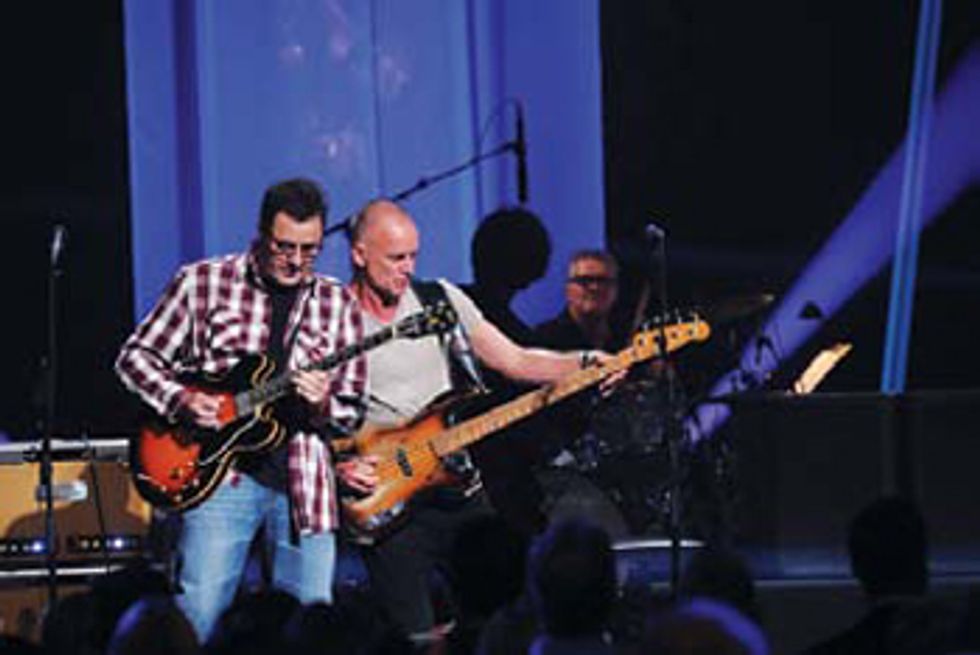
Yeah, I take the great ones out there. [For a
detailed look at Vince’s road gear, go to p.
130] They need to be played. What else you
going to do? I feel like with all those guitars,
since I’m not going to sell them it doesn’t
matter as much if I bang them up a little bit.
If you are all worried about the value of it, I
don’t know if you should have it in the first
place. For a player, it’s what you want to do.
They sound great and they feel great, why
wouldn’t you want to play them?
You use many of the members of your
live band on records. One of the mainstays
in your group has been keyboardist
John Hobbs. When did you two start to
work together?
John and I go back to the mid-’70s when
I moved to California. I was a 19-year-old
kid and he played on one of the first
records I played on out there. We were with
Byron Berline, a guy I used to work for
when I moved. We were friends and John
also played on the first record I did in ’83
as a solo artist. Eventually, he made his way
here to Nashville and I talked him into
going on the road a few years ago.
Tell me about who else is on the album.
Pete Wasner is another keyboard player that
always plays on my albums. We also write
songs together and he has been playing with
me for 30-plus years as well. Some of the
relationships I have with these guys are really
deep. Richard Bennett is a great guitar player
who I always lean on. He maybe is one of the
best supporting guitar players that I have ever
known. He’s an odd duck in that he never
really wants to play leads too often, but rather
playing parts and rhythm guitars. He is just
so great at coming up with really great stuff
that really makes the records special. His parts
are always a huge contribution to the records.
David Hungate, who is a great bass player, has
been playing in my band the last few years.
He used to be in Toto and played on a million
records over the years. It’s worth it to me
to go the extra mile and pay those guys what
their worth and what they deserve. It’s a great
experience to play music every night with
really gifted musicians. Life’s too short.
You recently did some work with Sting.
How was that?
Oh boy. It was more than amazing. It was
a life highlight. They have a show on CMT
called Crossroads and I picked four of his
songs and he picked four of mine. We sang
them together and it was just a great experience.
It was fun to find out how compatible
and similar we were. Our voices and our
range are similar. He is a no-nonsense guy
and I am a goofball. That may be the only
difference, but we are both really serious
about music and making sure it’s great. Great
stretch of a couple days working with him.
[In a British accent] I got to be a rocker.
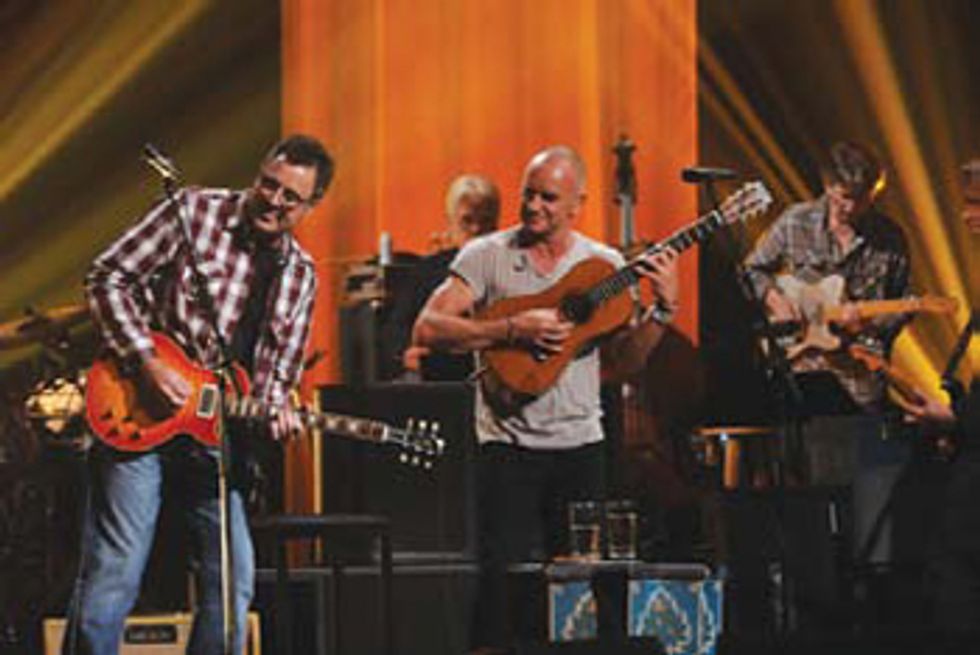
It’s well known that you were offered a
gig in Dire Straits and turned it down. At
this point in your career do you ever see
yourself playing in a band again?
Yeah, I do. I think that at this point in
life I’m not exactly having No. 1 record
after No. 1 record and I have my feet well
entrenched in country music but not to the
level I did 15 or 20 years ago, or even 10.
I would definitely entertain the thought.
Sting and I talked about going on the road
together as the Self-Righteous Brothers
[laughs]. I would like to do something like
what the Traveling Wilburys did. Find four
or five people from different places and do
something like that. If Clapton called and
asked me to be his other guitar player on
tour, I would say yeah. Maybe 20 years ago
it really wouldn’t work. It didn’t make sense
for me to do that with Mark [Knopfler].
The musician in me would have done it in a
heartbeat. The place that I was in I just felt
that it was the wrong thing to do, for me.
Alright, i am going to put you on the
spot. Who would be the other three artists
you would like to tour with?
Oh gosh. I would go out with Sting,
Michael McDonald, Sheryl Crow, maybe
Sonny Landreth. I could name you 20.
Eric and Mark, of course. I just think that
life is so short, and at 54 you really start to
see your mortality and realize you have less
time left than you have lived. So I would
be open for just about anything and really
always have been. I think my career bears
that out. Most hillbilly singers wouldn’t be
thought of as a duet partner with Gladys
Knight, Barbra Streisand, or Tim Finn. I
feel lucky I don’t have a place that I have to
land in all the time.
Photos by Rich Osweiler
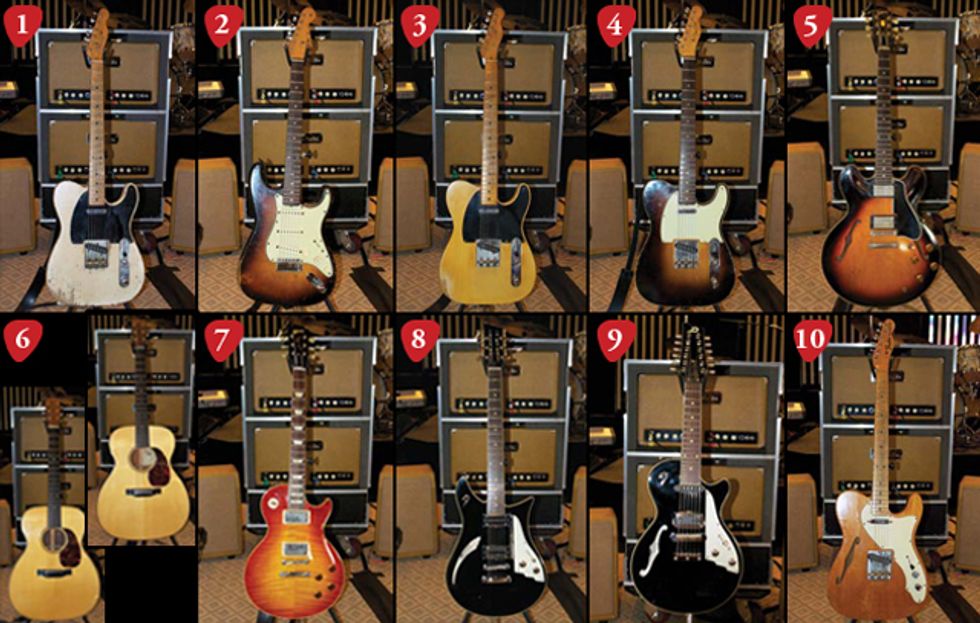
- This 1953 Fender Telecaster is Vince’s No. 1 guitar. He picked up the guitar at Del City Music in Del City, Oklahoma, nearly 30 years ago. According to Gill’s tech, Benny Garcia, everything is totally original except for a Seymour Duncan pickup in the neck position.
- This all-original 1959 Fender Stratocaster was purchased by Gill from Duane Eddy’s son. Each night, Gill changes his set list, and even what guitars he uses on each song, but recently he has been using this on “Pretty Little Adriana.”
- Gill acquired this 1952 Fender Tele, formerly owned by Larry Black, a few years ago and uses it on “Which Bridge to Burn.”
- This 1960 Fender Tele Custom used to belong to Gill’s writing partner Will Owsley. Tragically he took his own life. Gill tunes it down a half step and uses it on “I Still Believe in You” and “Take Your Memory.”
- 1960 Gibson ES-335 Dot Neck with a stop tailpiece.
- These Martin guitars are based on a George Gruhn design. The Quad 28 (left) has a herringbone inlay and the Quad 18 is a stripped-down version. Both feature D-Tar pickups.
- Mid-2000s Gibson Les Paul Deluxe with a chambered body. Gill usually keeps this guitar tuned down a half step.
- This Duesenberg Double Cat 12 is sometimes used on “Never Alone.”
- At a recent performance with Sting, Gill used this Duesenberg Mandola 12-String on Sting’s “Fields of Gold.”
- This mid-’60s Fender Thinline Telecaster goes through several different setups during the course of a tour. Here, Gill removed the sixth string and tuned it a la Keith Richards to open G (D–G–D–G–B–D). This guitar survived the Nashville flood, thanks to Joe Glaser.
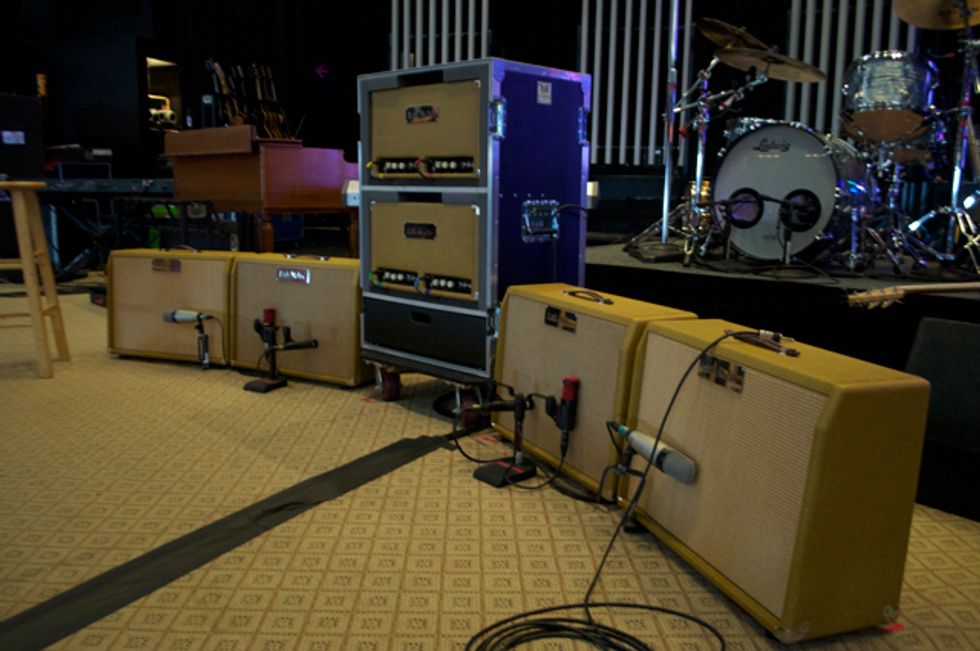
Gill routes his signal through a pair of Little Walter VG- 50 amps. Each head contains a pair of 50-watt Little Walter amps that are built into a special chassis that fi ts in a standard size head. Each amp has a Volume, Bass Roll Off, and Tone controls and are powered by a pair of Octal tubes in the preamp section (a 6SC7 and a 6SL7 Phase Inverter), and 6L6s in the power tube section. The top head is used for his Teles, with all the other guitars going through the bottom head. Each amp goes to its own Little Walter 1x12 cabinet, which were built to the exact dimensions of a Fender Deluxe Reverb, and loaded with Celestion G12T-75 speakers.
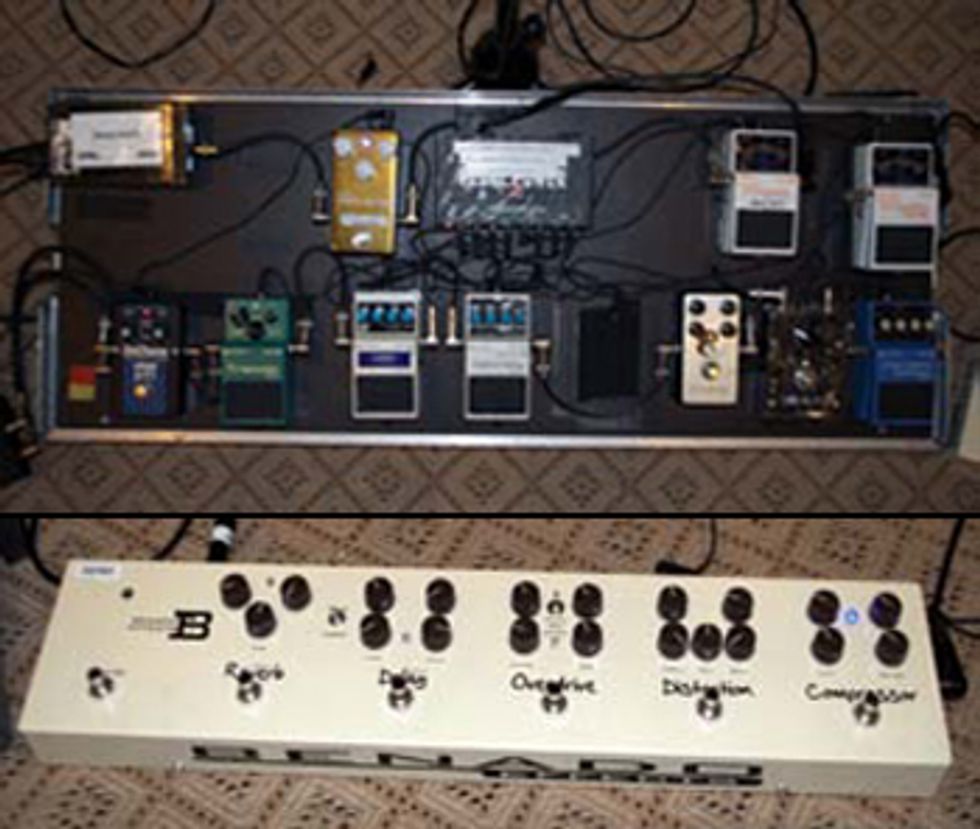
Custom Audiotech Guitar Systems A/B splitter, EBS UniChorus, Boss TR-2 Tremolo, Robert Keeley-modified Boss DD-3 Digital Delay, Boss DD-3 Digital Delay, Hermida Audio Zendrive, Creation Audio Labs MK.4.23 Clean Boost Pedal, Boss CS-3 Compression Sustainer, (2) Boss TU-2 (one for electric, one for acoustic), Wampler Faux Spring Reverb, Benado Effects Pedalboard.
On Gill’s main pedalboard he uses an EBS UniChorus, Boss TR-2 Tremolo, a Robert Keeley-modifi ed Boss DD-3 Digital Delay, a stock Boss DD-3 Digital Delay, Hermida Audio Zendrive, Creation Audio Labs MK.4.23 Clean Boost, Boss CS-3 Compression Sustainer, 2 Boss TU-2 tuners (one for electric and one for acoustic), and a Wampler Faux Spring Reverb. A Voodoo Lab Pedal Power 2 powers all of the pedals and he puts the signal through an Audiotech Guitar Systems A/B splitter and then out to all four inputs of his amps. Gill also uses a Benado Effects pedalboard with reverb, delay, overdrive, distortion, and compressor units enclosed.
D’Addario .010–.046 on standard-tuned guitars, D’Addario .0105–.048 for guitars tuned down a half step, Planet Waves medium picks, Voodoo Lab Pedal Power.




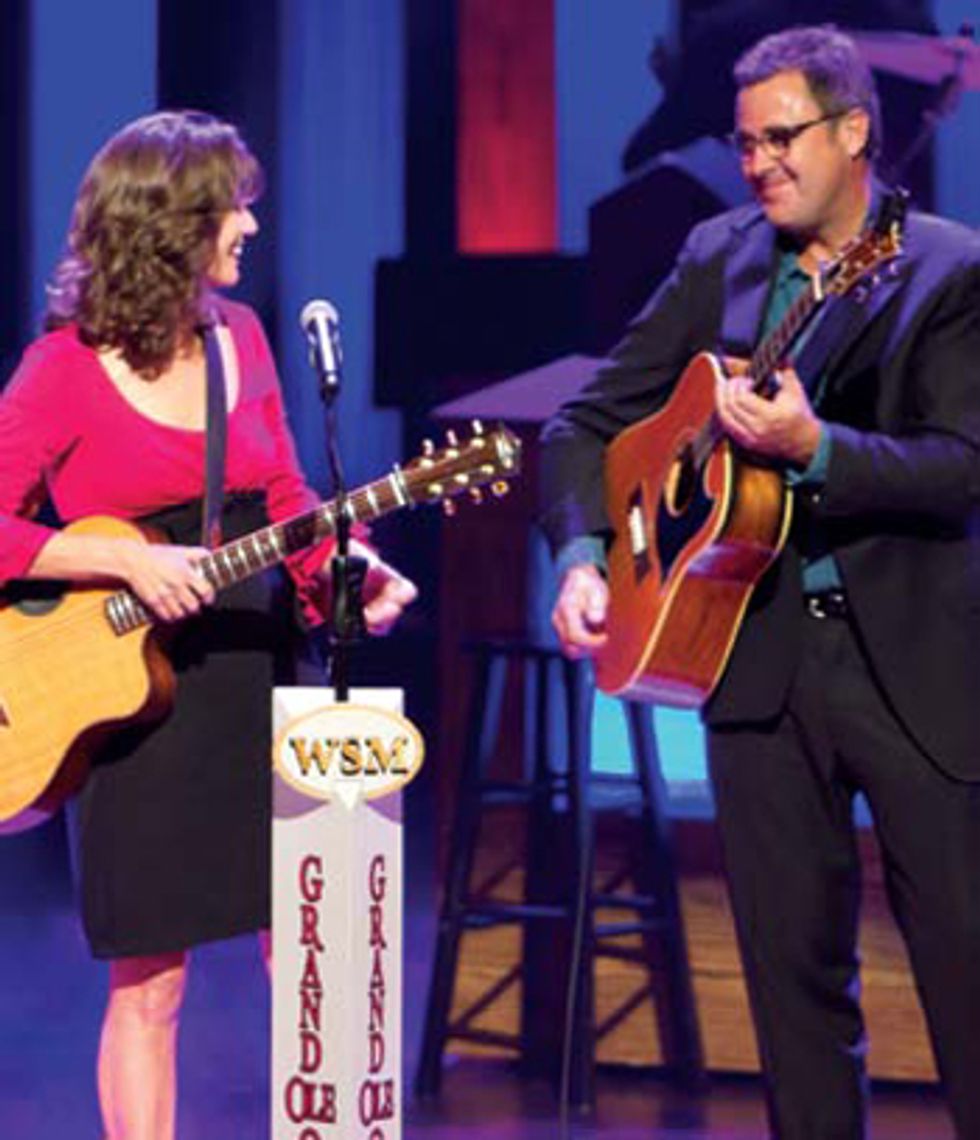
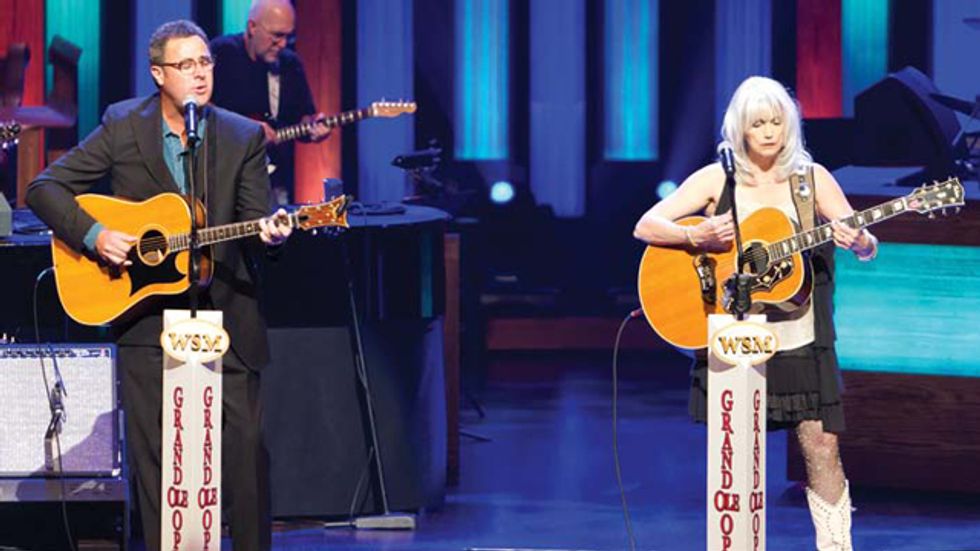
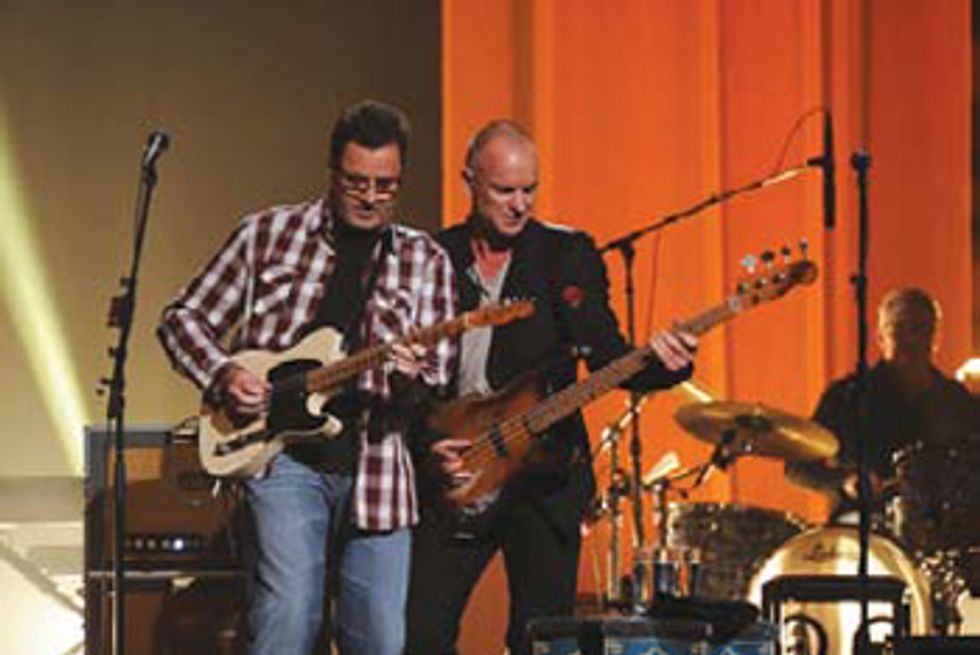










![Rig Rundown: Russian Circles’ Mike Sullivan [2025]](https://www.premierguitar.com/media-library/youtube.jpg?id=62303631&width=1245&height=700&quality=70&coordinates=0%2C0%2C0%2C0)










![Rig Rundown: AFI [2025]](https://www.premierguitar.com/media-library/youtube.jpg?id=62064741&width=1245&height=700&quality=70&coordinates=0%2C0%2C0%2C0)




















 Zach loves his Sovtek Mig 60 head, which he plays through a cab he built himself at a pipe-organ shop in Denver. Every glue joint is lined with thin leather for maximum air tightness, and it’s stocked with Celestion G12M Greenback speakers.
Zach loves his Sovtek Mig 60 head, which he plays through a cab he built himself at a pipe-organ shop in Denver. Every glue joint is lined with thin leather for maximum air tightness, and it’s stocked with Celestion G12M Greenback speakers.











